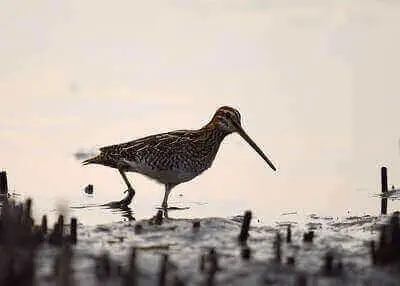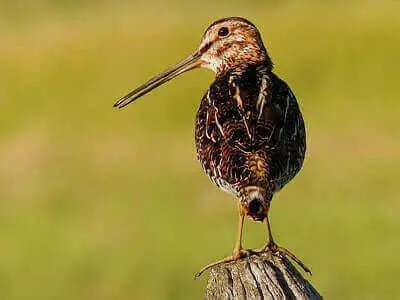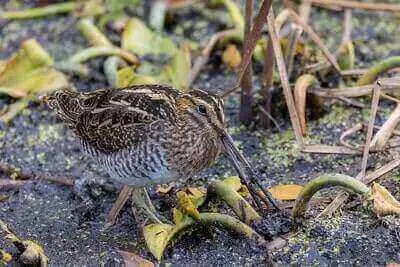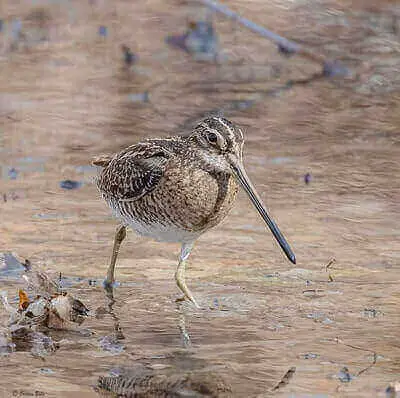Disclosure: We may earn commissions if you purchase products after clicking on a link from our site.
Ever wondered how to hunt snipe? Do you want to learn how to hunt snipe? Snipe hunting can be challenging as they rarely fly straight and are quick to seek cover.
They are also erratic in flight which makes it more challenging to hit them when in flight. In this article, we share information to help you be successful with bird hunting.

Table of Contents
Snipe Behavior
They tend to fly a short distance and dive back into vegetation cover when flushed. When it gets back on the ground, they run quickly and are difficult to flush for the second time.
This makes it challenging when you are on a snipe hunt. Moreover, this bird flies erratically as they don’t fly straight and will quickly find cover.
Moreover, it flies at a top speed of more than 60 miles per hour. With its small size, slender profile, and how it blends seamlessly with its surroundings, it can be challenging.

Snipe Habitat
Snipe can be found in marshes, mudflats, potholes, river and lake edges, and drainage ditches. They can also be found in bottomlands, wet agriculture fields, flooded pastures, and mucky croplands that provide protection from predators. They are found feeding on worms, larvae, and other invertebrae using their long, prehensile bills.
It is more than just shallow water, mud, or moist soil as they need the right mix of food and cover to protect them from predators while they feed and rest.
Meadows & Bottomlands
They are often found in large swaths of moist or seasonally flooded bottomlands. These bottomlands and meadows will often be close to potholes or other bodies of water. They can be found feeding on worms, insects, and invertebrae; this is Snipe Country.

Potholes
Potholes are frequented by snipe as worms and other things snipe feed on can be found there. Most potholes are seasonally flooded which makes it ideal for bird hunting.
If you find potholes, move to them with the wind at your back and work the perimeter. It will be common to bump birds as you move through the potholes.
River & Lake Edges
You can also find snipe along the river and lake edges. Bodies of water with soft and gently sloping banks that feature a gradual transition from water to mud to cover will have snipe.

Cow Pastures
Active cow pastures are good habitats for snipe. Where there are cows, you will find dung and mud. And this makes an ideal habitat for snipe.
Cow pastures with watering holes, potholes, and low areas that are seasonally flooded with gentle slopes are ideal habitats for targeting snipe.
Irrigation Ditches
Irrigation ditches are also very attractive for snipe. Irrigation ditches are created to provide water for agricultural projects.
This irrigation creates wet and soft areas that attract snipe. They will be found along the many miles of ditches feeding on worms, insects, larvae, and invertebrae.

How To Hunt Snipe
When hunting Wilson’s snipe, the hard work is to find where they are located. They are always around soft ground searching for worms, larvae, and other invertebrae.
Once you find these areas, it comes down to focusing on the bird as you flush snipe. Do not focus on your weapon as it can cause you to stop your swing and shoot behind or under the bird most of the time. There is no need for predator calls, decoys, or other gadgets. A snipe hunt is very simple.
Snipe hunting can be done with or without dogs. Snipe hunters use dogs to retrieve the bird while other hunters target snipe without dogs. A 12 or 20-gauge gun with a No. 9 or No. 8 shot will work on a snipe hunt.
Snipe Hunting Season
Bird hunting season for snipe is different for states. Some start in September and end in November, while others run from November to February in the south.
Always read the laws of the state you want to hunt snipe in. Bag limits vary; however, most have a bag limit of 8 birds. Additionally, you will need a hunting license and a game bird stamp for snipe hunting.

Best Dogs Breeds For Snipe Hunting
Flushing dogs are not the best choice for snipe. Flushing and retrieving breeds do a better job, but the best is the retrieving breed. What is important for a dog when snipe hunting is that it is obedient, under control, intelligent, and confident dogs.
The dog will retrieve snipe in soft and wet areas. There may be transitions from solid ground to marshy and muck areas. Some dogs quickly get intimidated by this wetland and find it difficult to adjust. Others, on the other hand, figure it out and adapt to the area.
The Labrador retriever, Golden Retriever, Standard Poodle, Chesapeake Bay Retriever, and Nova Scotia Duck Tolling retriever are some of the best dogs for hunting snipe. You can read about the best hunting dog breeds if you want to learn more.

The Bottom Line
Snipe hunting is exciting and challenging. Many hunters prefer duck hunting, quail, pheasant, and hunting other species of birds than snipe.
However, that doesn’t mean that it is not rewarding. Some hunters consider it a wild goose chase or a fool’s errand. These shorebirds are fast and fly erratically which will put your shooting skills to the test.
Additionally, they blend with their environment which also compounds the challenge of snipe hunting. In this article, we shared information to help you be successful when snipe hunting.
If you hunt quail, dove, turkeys, ruffed grouse, goose, and pheasants, then you can read the best dove hunting tips, best quail hunting tips, how to scout turkeys, best ruffed grouse hunting tips, best goose hunting tips, and the best pheasants hunting tips.